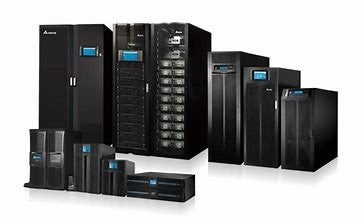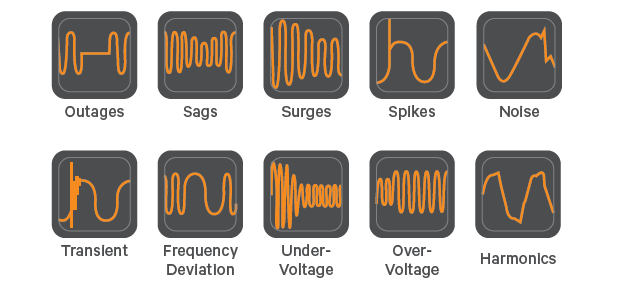

UNINTERRUPTED POWER SUPPLIES (UPS)
UPS are used to manage and condition line voltages to your critical/non critical loads. It acts as a filter to prevent damaging AC line voltage disturbances which can host a multitude of hidden problems. Furthermore, it also acts as an AC power source providing a battery back-up in case of complete power interruption.
UPS technologies
- Standby
- Line Interactive
- True Online - Double Conversion
Offline / Standby Technology
This technology offers basic power protection assisted by some line conditioning features. It should be used in noncritical situations where all that's required is mainly AC power in case of a power outage. These models will often come with Telephone & Data line protection (limited protection).
In Summary:
- Most basic power protection (use in noncritical loads)
- Extremely cost effective
- Solicited only on power shortages (transfer time req’d)
- Will handle light Sags and Surges
Line Interactive Technology
This technology offers a compromise between line conditioning and price. Although it has same features as the Standby, it bucks and boosts voltages when over and under voltages are detected without use of its batteries. It will yield a cleaner conditioned output and prevent batteries from being solicited unnecessarily and hence, rolonging UPS battery life.
In Summary:
- Intermediate power protection (semi-critical loads)
- Cost effective but pricier than Standby technology
- Solicited on power outages and provides more line protection (transfer time req’d)
- Less solicitation of batteries for power corrective measures (Buck & Boost)
Double Conversion Technology
This technology offers the best power protection money can buy. It will yield a clean perfectly conditioned AC Sinewave output. The UPS internal circuitry ensures that the AC line feed doesn’t ever see the load, hence preventing any AC line problems to transfer to your critical loads. If you have a critical load to protect, this is THE technology to buy.
In Summary:
- Best protection money can buy (Zero Transfer Time)
- For equipment with very sensitive power fluctuations
- Ideal when linked to a Generator for total Zero Downtime AC Power
UPS are offered in Single and Three Phase configurations.
In single phase units, each category offers an increased power protection enabled by their internal circuitry and components. Most of these UPS can have external battery cabinets which will increase run times of your loads under power failure conditions. As power failures occur, Standby and Line Interactive UPS will have a transfer time between AC line outage and battery kicking in (usually approx. 4ms). On the other hand, Double conversion units have NO delay since the batteries are providing continuous power as they are On-Line and not subjected to any delays (see schematic below).
Three phase systems are usually used in high capacity configurations. They’re ALL True Online – Double Conversion systems as they’re mainly used for mission critical applications (IT Servers, Emergency Equipment, Safety, and many others). This technology was later mutated to single phase systems and hence the reason of their availability in smaller capacities today.
UPS Options
UPS have a number of accessories and options available to meet your specific needs. Here are some examples:
- Extended Battery Cabinets
- Ethernet and other types of communications
- Relay Cards
- Redundancy (N+1 or Multiple)
- Tower or Rackmount models
- Power Distribution Cabinets
- Cooling
- Smart Metered and Monitored Power Bars
- Environmental Sensors (Temperature, Humidity)
- Monitoring Software
Power Factors
This is one element that is often misinterpreted by many. In short, Power Factor determines the efficiency of your unit. The higher the values match between VA – Watts, the more efficient your unit operates. Often, the VA output will be more than the actual Watt value. This is due to loss of efficiency during the transfer stages between input power and output. The loss of efficiency is often associated to heat dissipation, fans and certain other internal components. Efficiency is also related to extra costs when running your unit since the load is not getting it’s real dose of expected power.
Today, we have UPS that give up to 1:1 VA-W outputs. This means NO loss of efficiency and maximizing your operating costs.
Many will look at how much they can save when they buy a UPS. They only discover that it was perhaps not much of a deal when they calculate what it costs to run it and add it to the initial cost of purchase.
| Features | Standby | Line Interactive | Double Conversion |
| Zero Transfer Time | Yes | No | Yes |
| Frequency Regulation | No | No | Yes |
| Voltage Regulation | No | Some | Yes |
| Eliminates Noise and Transients | Some | Some | Yes |
| Generates New Sine Wave Continuously | No | No | Yes |
| Power Outage Protection | Yes | Yes | Yes |
| Internal Filtered Dynamic By-Pass | No | No | Yes |
| Power Factor Correction | No | No | Yes |
| Harmonic Correction | No | No | Yes |
DAMAGING POWER PROBLEMS

TECHNOLOGIES





